A technical zoom-in to NEM
This article aims to provide a technical zoom-in on the NEM NIS code in order to better understand how things fit together and give readers the leads to more easily delve into further research.
Tech Stack
- Java 8 (Java 11 in dev branch)
- Spring Framework (v4.3.30)
- Jetty Web Server (v9.4.43)
- Hibernate ORM (v4.3.11)
- H2 Database (v1.4.200)
- Flyway for database migration
- Maven for dependency and build management
High Level View
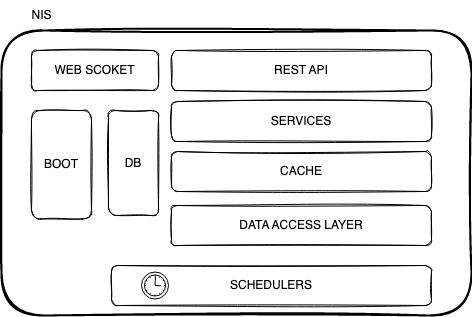
Modules
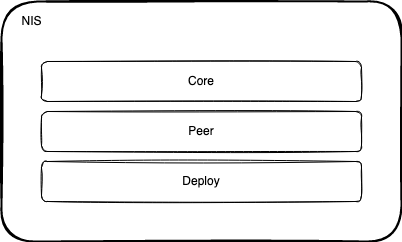
The NEM codebase is organized into several modular packages, each of which serves a specific function within the overall platform. Here’s a brief overview of some of the main modules.
Core
Packages within this module starts with org.nem.core. These packages provide the following functionality:
- cryptographic and serialization base methods
- timer and async classes/helpers
- data types for transaction, states and node
- time provider and synchronization
- common utility (collections, encoders)
Peer
Packages within this module starts with org.nem.peer. This module provides base methods for
- synchronization, network state
- connection to nodes
- authentication on nodes
- reputation management algorithm implementation (EigenTrust)
Deploy
Packages within this module starts with org.nem.deploy
Main functionalities are, Logging, bootstrapping, serialization, property file handling and server instantiation.
NIS
(NEM Infrastructure Server) NIS is the core component of the NEM platform, responsible for maintaining the integrity and security of the blockchain. It handles tasks such as validating transactions, creating new blocks, and managing the overall state of the network depending on the core, deploy, peer modules.
This Java package provides everything needed to launch a NEM node.
Building from source
git clone https://github.com/NemProject/nem.git
cd nem
mvn clean package -DskipTests
Bootstrapping NIS
In the NEM blockchain, CommonStarter class(main) is the entry point to bootstrapping NEM Infrastructure Server (NIS) node.
To bootstrap a NIS node, the CommonStarter class performs the following tasks:
- instantiates the ApplicationContext and loads configuration
NisAppConfigclass instantiates beans(objects managed by the Spring IOC)- Datasource
- DB migration (flyway)
- Blockchain objects
- Cache
- Harvester
- NisMain (*important please see
NisMain.initmethod which runs on PostConstruct) - and more
- instantiates
NemServerBootstrapperfor http server - instantiates
NemWebsockServerBootstrapperfor web socket server
Here is how you can start a NIS node:
java -Xms6G -Xmx6G -cp classpath_libs org.nem.deploy.CommonStarter
Ideally it will require min 6GB of RAM to run a NIS node in a production environment.
Configuration
There are several configuration files within the NEM codebase:
- config(.*).properties
- db.properties
- logalpha.properties
In order to overwrite any of the configuration, the files must be located in the classpath.
config(.*).properties file
Here is the configuration hierarchy for config.properties:
NisConfigurationPolicy
NisConfiguration
CommonConfiguration
merge:
config-default.properties
config.properties
config-user.properties
Within the hierarchy config.properties will overwrite the config-default.properties and config-user.properties if defined will overwrite the values in config.properties.
Here is the list of possible values to configure:
nem.folder = %h/nem
nem.protocol = http
nem.host = 127.0.0.1
nem.httpPort = 7890
nem.httpsPort = 7891
nem.websocketPort = 7778
nem.network.nemesisFilePath:
nis.bootKey:
nis.bootName:
...
db.properties file
This file contains the database connection configuration. Usually the values in this file don’t need to be updated.
Here is the default configuration file content:
jdbc.driverClassName=org.h2.Driver
jdbc.url=jdbc:h2:${nem.folder}/nis/data/nis5_${nem.network};DB_CLOSE_DELAY=-1
jdbc.username=
jdbc.password=
hibernate.dialect=org.hibernate.dialect.H2Dialect
hibernate.show_sql=false
hibernate.use_sql_comments=false
hibernate.jdbc.batch_size=20
hibernate.query.startup_check=false
flyway.locations=db/h2
logalpha.properties
NEM uses java.util.logging. Default logging level is INFO.
If it’s needed to change the default logging level, one of the levels listed below can be used.
OFF
SEVERE
WARNING
INFO
CONFIG
FINE
FINER
FINEST
ALL
Here is the default configuration file:
handlers = java.util.logging.ConsoleHandler, java.util.logging.FileHandler
.level = INFO
java.util.logging.ConsoleHandler.formatter = org.nem.deploy.ColorConsoleFormatter
java.util.logging.ConsoleHandler.level = INFO
java.util.logging.FileHandler.formatter = org.nem.deploy.NemFormatter
java.util.logging.FileHandler.limit = 100000000
java.util.logging.FileHandler.count = 100
java.util.logging.FileHandler.pattern = ${nem.folder}/nis/logs/nis-%g.log
java.util.logging.SimpleFormatter.format = %1$tY-%1$tm-%1$td %1$tH:%1$tM:%1$tS.%1$tL %4$s %5$s%6$s (%2$s)%n
REST API
REST API Controllers reside under org.nem.nis.controller package.
Some of the Controller classes are:
- AccountController
- AccountInfoController
- AccountTransfersController
- BlockController
- ChainController
…
Let’s focus on one of the controllers and bringAccountTransfersControllerunder spotlight.
First off, all of the REST controllers are annotated with @RestController which is a Spring Web Framework annotation that is indicating that the class is a controller that serves RESTful web services and the methods in the class will handle web requests and return the response body.

NEM API annotations:
- AuthenticatedApi: Expects a node challenge param(a random 64-byte payload), signs the challenge data with the private key, attaches signature to the response for the caller to verify
- P2PApi: Marker annotation denoting callable by peers
- ClientApi: Marker annotation denoting the api is callable by the client
- PublicApi: Marker annotation for a public api (should be all GET method based), any PublicApi is also a ClientApi
- TrustedApi: Allows only local callers (prevent remote callers)
You can search for these annotations to find related API endpoints in the code.
For P2P endpoints please see org.nem.core.node.NisPeerId class and also org.nem.core.connect.client.NisApiId for the client API endpoints.
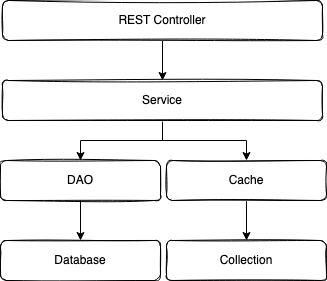
How does peer to peer communication work?
When the node boots, during the peer network boot, it loads the initial(pre-trusted) peer list from the peer-config_[mainnet|testnet].json file.
During the boot there is a scheduled task created with the name REFRESH (in PeerNetworkScheduler.addTasks) to refresh the peer nodes.
NodeRefresher (triggered by the scheduled task REFRESH) refreshes the peer list, by making authenticated calls to node/info and /node/peer-list/active and stores the info in the local cache on a peer (selected using PreTrustAwareNodeSelector).
Peers call @P2PApi annotated API endpoints, mostly authenticated by sending a challenge and verifying the returned signature(whether signed by the expected node).
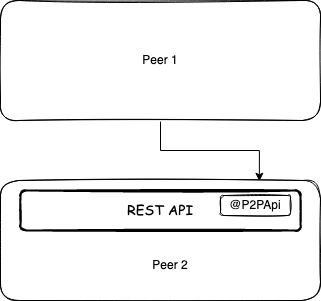
How does a peer trust a peer? EigenTrust algorithm, Node Experiences
During the boot, there is a scheduled task updateNodeExperiences created with a complex delay strategy can be seen below.
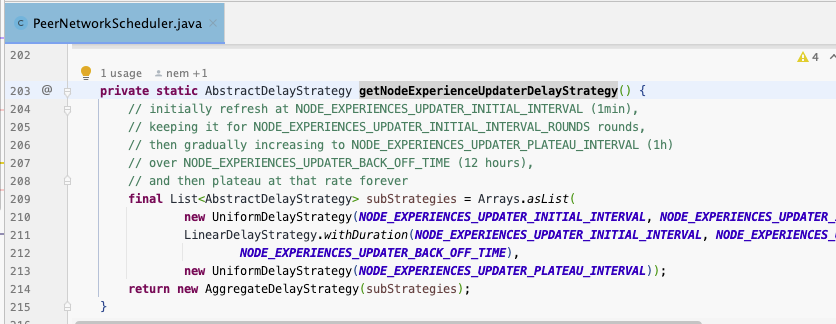
When this task is triggered, NodeExperiencesUpdater makes an authenticated call to /node/experiences on a peer (selected using PreTrustAwareNodeSelector) and stores the NodeExperiencesPair(which then will be used to calculate the trust score to the nodes) in the local cache.
NodeExperience represents experience one node has with another node and consists of successfulCalls, failedCalls and lastUpdateTime fields.
Then this information is used in the trust score calculation.
Eigentrust(++) Algorithm
EigenTrust++ is a reputation management algorithm that was developed to improve the accuracy and efficiency of reputation systems in peer-to-peer (P2P) networks. It is based on the idea of using the collective behavior of a group of peers to evaluate the trustworthiness of individual peers.
“Having a reputation system for nodes allows nodes to select their communication partner according to the trust values for other nodes. This should also help balance the load of the network because the selection of the communication partner only depends on a node’s honesty but not its importance.”
https://nemproject.github.io/nem-docs/pages/Whitepapers/NEM_techRef.pdf
The EigenTrust++ algorithm uses a combination of local and global reputation information to calculate the reputation of a node. Local reputation is based on the direct interactions of a node with its neighbours, while global reputation is based on the collective behaviour of the entire network.
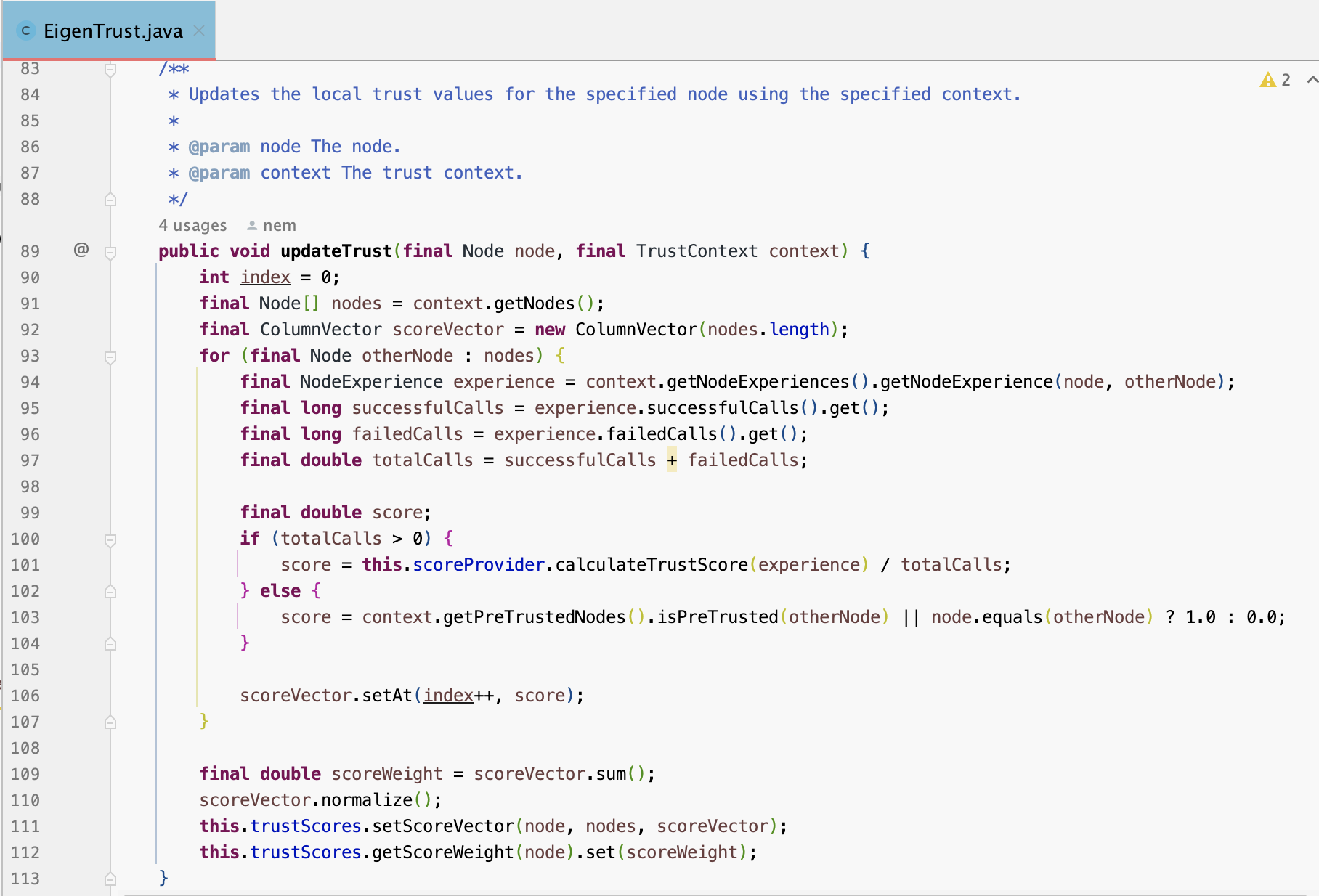
In the EigenTrust algorithm, malicious nodes could collude and report
low trust values for honest nodes and high trust values for dishonest nodes. To mitigate this risk NEM uses EigenTrust++ algorithm which additionally calculates and uses a node’s credibility based on the shared experiences of that node with other nodes; if the experiences are similar then we can say the node is more credible/honest.
EigenTrustPlusPlus class extends EigenTrust class in the NEM code.

Before any peers picked by the local node to interact with, it picks the peer considering the trust score of the candidate peer.
Block synchronization
As already mentioned, recurring tasks are being handled with the scheduled tasks that are created in the PeerNetworkScheduler class.
One of the scheduled tasks is PeerNetwork.synchronize() with the name SYNC which is scheduled to run every 3 seconds.
This scheduled task runs BlockChain.synchronizeNode in the end, as it can be seen in the following image call hierarchy.
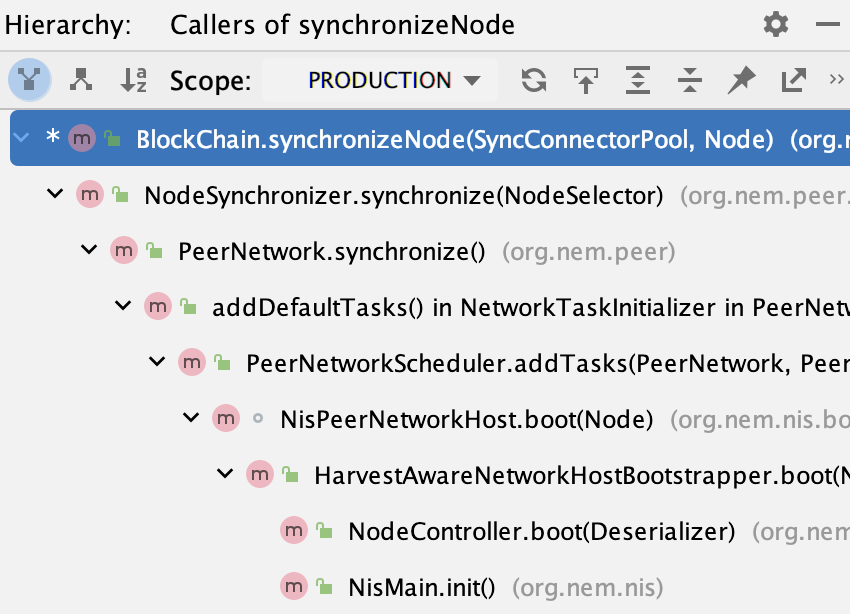
Block synchronization logic can be seen in the following image.
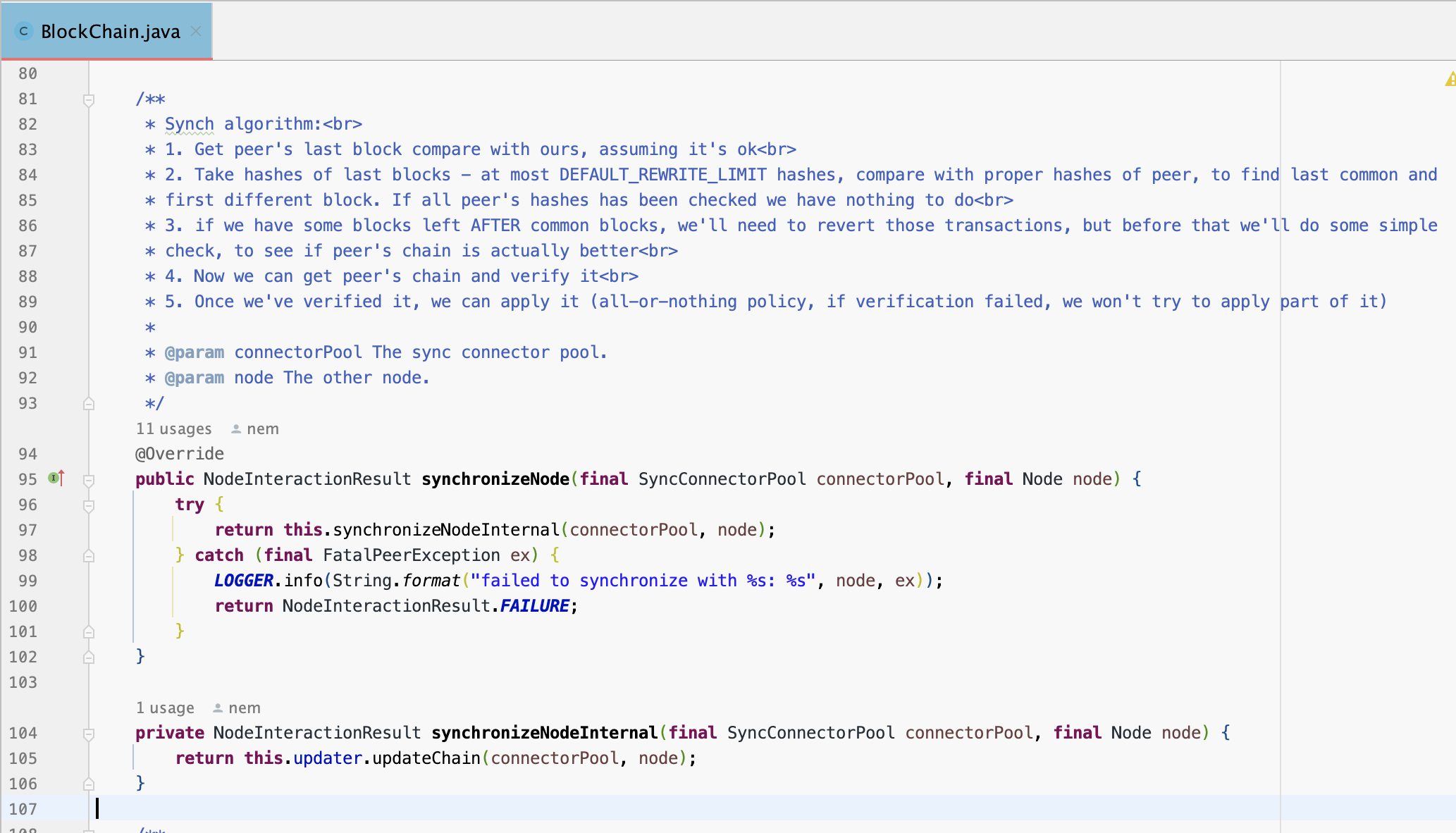
One thing to note is, during synchronization when BlockChainConfigurationBuilder.blockChainRewriteLimit(default 360) is exceeded the synchronization will not be successful(which will require a synch from scratch).

Broadcasting data
The data(Transaction(s), block(s)) to be broadcast is enqueued to BroadcastBuffer.
The scheduled task with the name BROADCAST BUFFERED ENTITIES pushes the buffered entities to the peers every second.
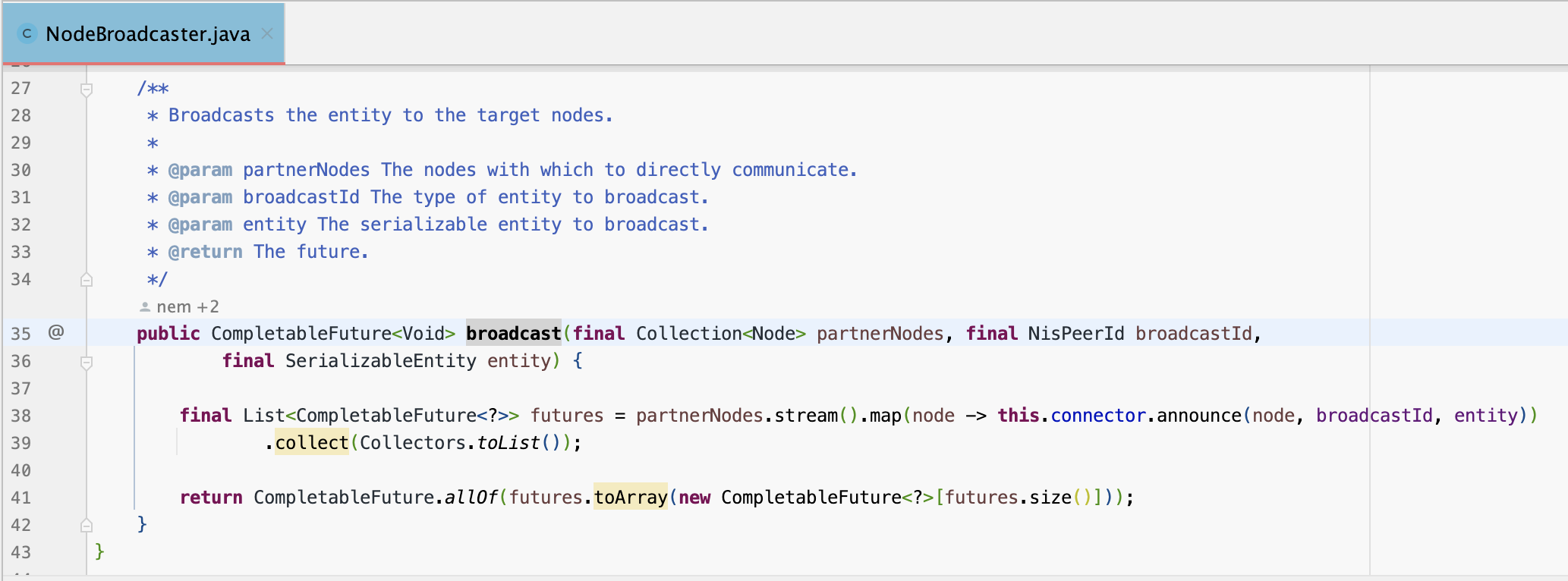
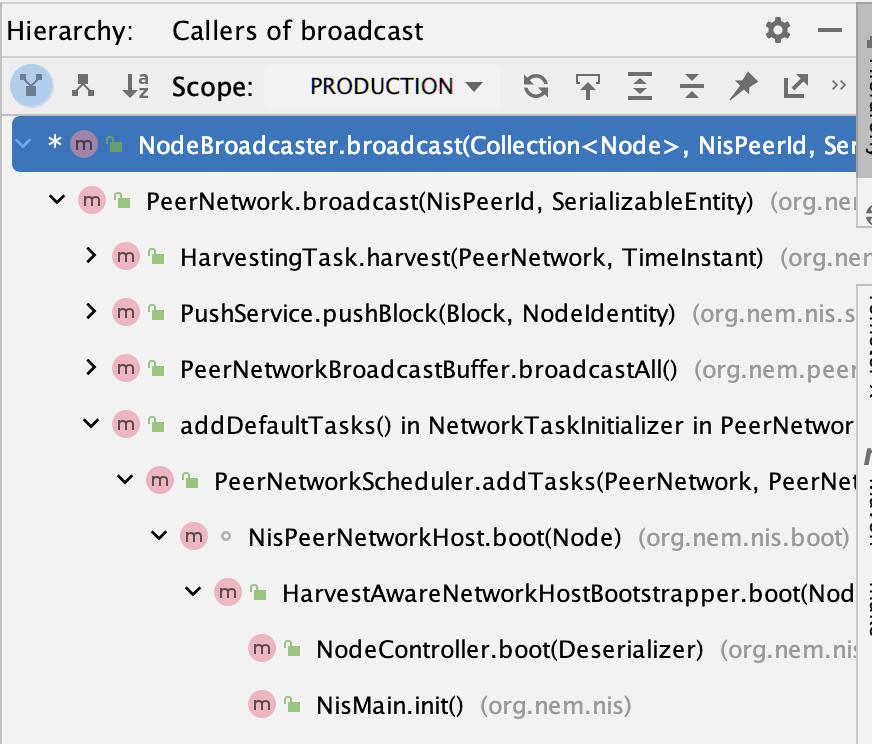
PushService.pushTransaction() and PushService.pushBlock() methods are being utilized through the process.
Time synchronization
NEM blockchain uses a custom time synchronization logic which is triggered by a scheduled task named TIME SYNCHRONIZATION. It starts with synchronizing every minute then over time, after getting mature, it starts to sync every 9 hours.
See the below image explaining the time synchronization logic(read more on https://nemproject.github.io/nem-docs/pages/Whitepapers/NEM_techRef.pdf).
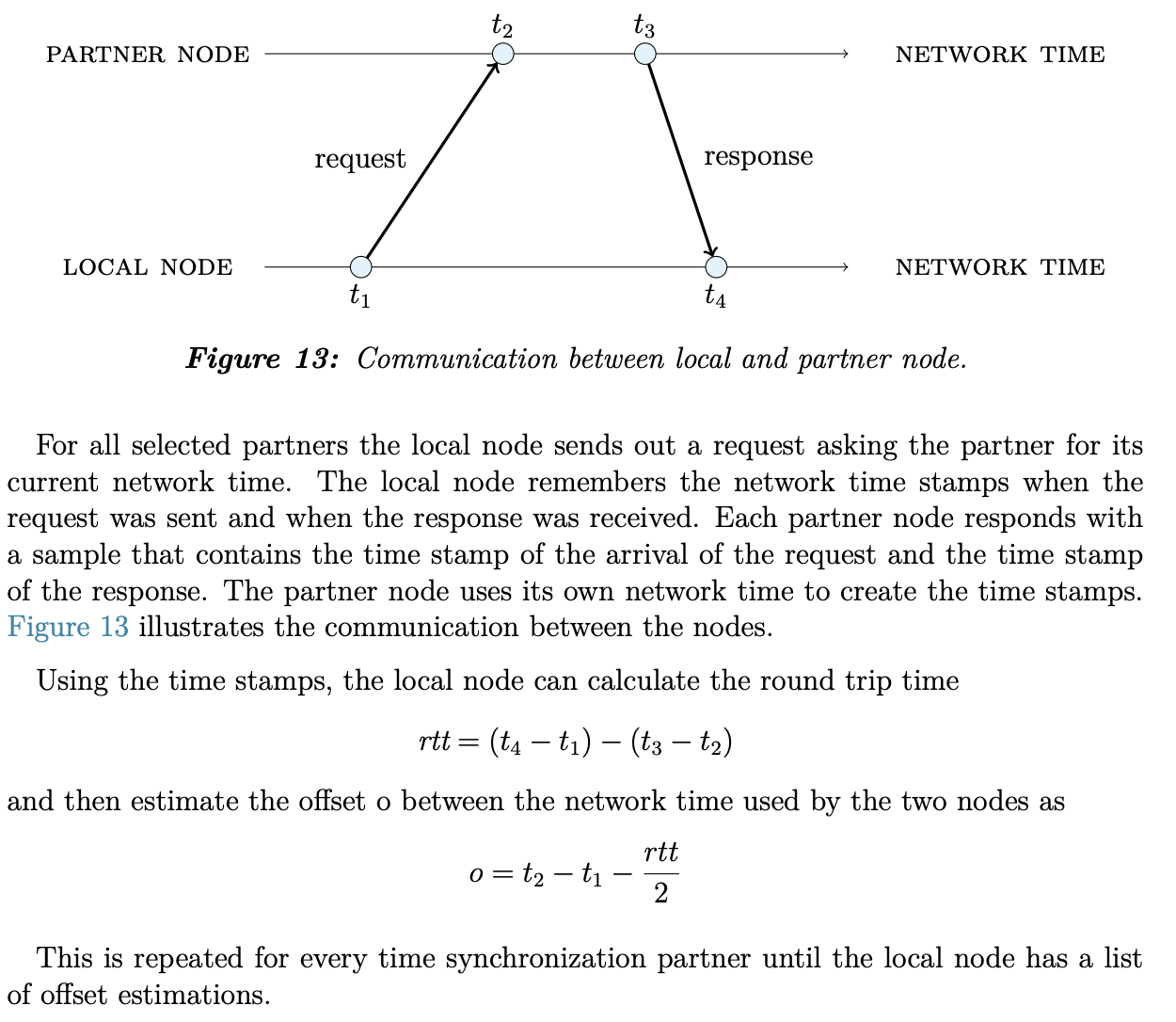
See NisTimeSynchronizer class which does the time sample collection in the code.
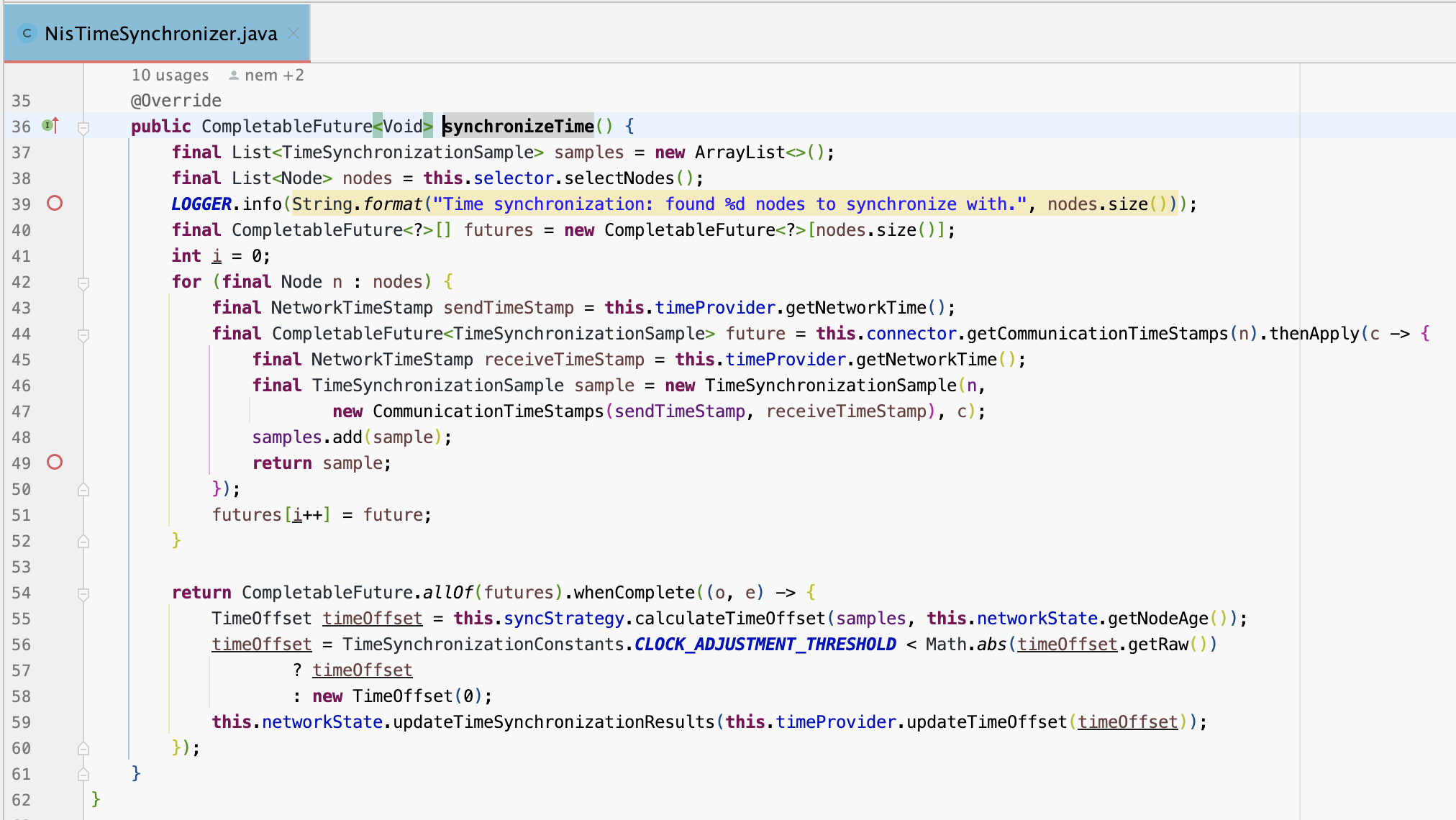
Harvesting
There is a scheduled task called FORAGING which is responsible for running the harvesting logic every second(see PeerNetworkScheduler.addForagingTask).
HarvestingTask.harvest method is being called by this scheduled task, which drops the expired transactions first, then tries to harvest a block for every unlockedAccount(accounts that are delegating to that node).
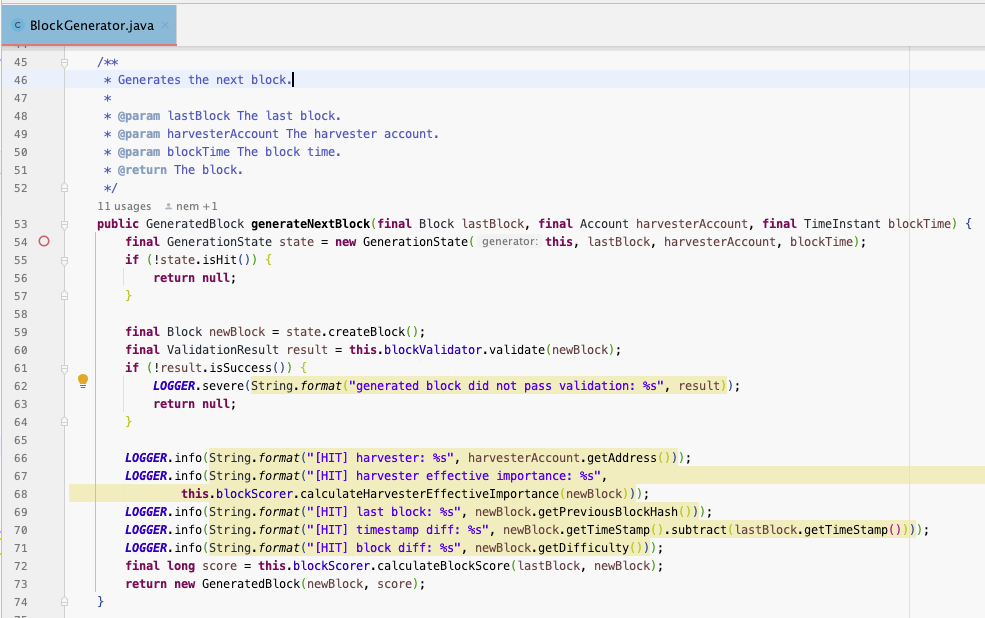
state.isHit() method checks if the calculated hit is lower than the target then it’s a hit, meaning it is a successful candidate block; if the all of the below validations passes and block score is the best amongst other candidates.
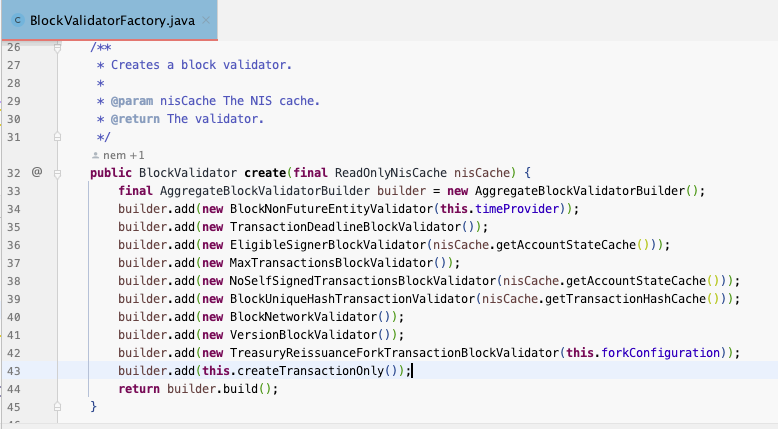
Here is how the hit and target values are calculated:
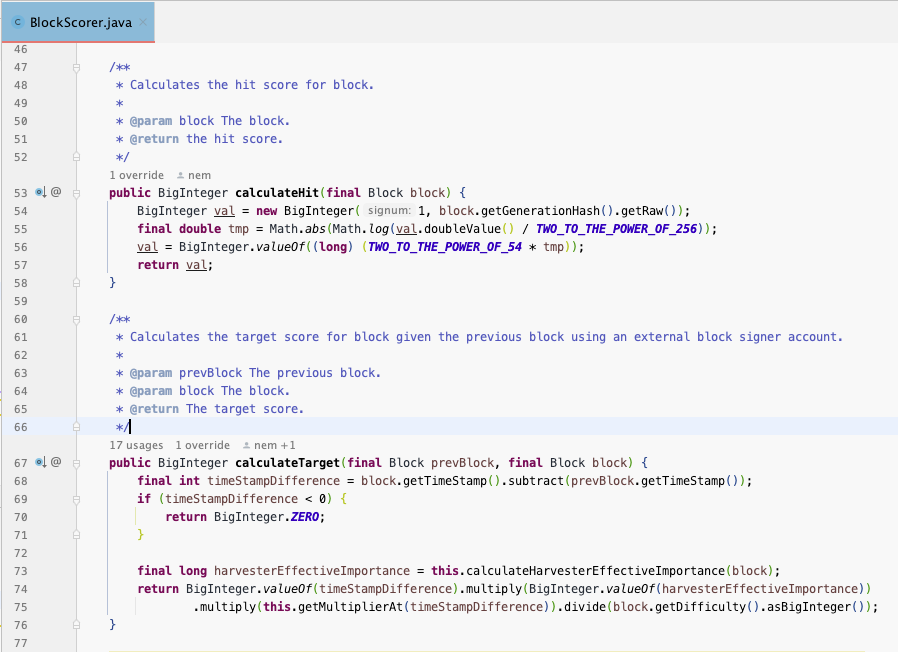
Wrapping up
I tried to take a closer look at NEM codebase in this article. I’m sure it is barely a scratch on the surface. The goal here was to expose some leads for you to follow easier for a better understanding in a short article. I hope it helps :)
Thank you for reading!